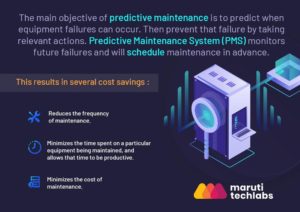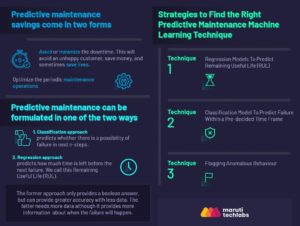How to Find the Right Machine Learning Techniques for Predictive Maintenance?
On a daily basis, we depend on multiple systems and machines, whether that is a car to travel or a plane to fly from one place to another. In order to reduce system failure, we need to be in a position to accurately predict when that failure might occur and have corrective actions in place. This can assist in major cost savings, better predictability, and greater availability of the systems. This is precisely why there’s a dire need for Predictive Maintenance with Machine Learning.
Let’s take the example of a taxi company to understand this. If you want the cars to keep running on schedule and not break-down during peak working hours, you’d want to ensure proper maintenance of all the moving parts. Generally, there are two thought processes when it comes to eradicating break-down or failure.
You can either be conservative about it and schedule periodic maintenance. In this case, you are less likely to have a complete understanding regarding the lifecycle of your machine and factors which realistically cause the break-down. This case is also likely to be more cost-intensive since the process does not focus on extracting the maximum value from the machine before scheduling maintenance. So, for example, you’ll probably change the tires before they complete their life cycle and change the engine oil before it is thoroughly utilized. As a result, you’ll end up spending more on maintenance.

The second thought process is to be calculative and base your decisions on predictive data analytics. Predictive Maintenance uses Machine Learning to learn from historical data and use live data to analyze failure patterns. Since conservative procedures result in resource wastage, Predictive Maintenance using Machine Learning looks for optimum resource utilization and predicting failure before they happen. As a result, Predictive Maintenance avoids both extremes and looks to find the perfect middle ground.
Read more: Machine Learning’s Vital Role in Malware Detection
But how do you find the perfect middle ground? Which Machine Learning technique do you use? In this article, we look at how you can find the right techniques that can be utilized, in order to successfully carry out Predictive Maintenance using Machine Learning.
Collect Data
The first step should be to collect data. The machine or system whose failure is to be predicted needs to be monitored at all times. The data generated from the monitoring system will need to be segregated to understand the various conditions and factors affecting the machine. So, for example, to understand car engine failure, the sensors should record temperature, moisture, oil level, oil density, etc. This information will provide the impetus to track and predict the failure pattern and cause. Data for Predictive Maintenance is time-series data.
When setting the sensors to monitor the system, here are some of the questions which the data should look to address:
- We need to identify the types of failures that generally occurs. So, the first task should be to recognize them and then locate the ones that we need to predict.
- Next, we need to characterize the failure process. Does the failure process happen over time, like in the case of brake-shoes gradual wear and tear or is it an acute problem, like engine water-logging?
- In the next step, we’ll need to identify which parts or processes are related to each type of failure. The different parameters which will elucidate information regarding the processes will need to be decided. Accordingly, monitoring mechanisms will have to be put in place to measure and track each parameter and the respective parts/processes.
- Generally, the lifespan of a machine exists for a period of years. As a result, the monitoring data needs to be collected over a long period to document the degradation process properly.
- Generally, it is advisable for data scientists and subject-matter experts to work jointly in collecting data. The subject-matter expertise is an integral part of understanding the machine and accordingly creating a schema for the data collection. Similarly, the data scientists need to be present in order to ensure that the data collected is useful and needs as minimal sanitation as possible.
However, in real-life scenarios, this is hardly the case. Most organizations track data on their own. As a result, by the time the data scientists arrive, a significant amount of data has already been collected and restarting the data collection process could significantly set back the entire process.
As a result, instead of collecting data based on a pre-decided model, a model is framed in order to best suit the data at hand.
Predictive Maintenance Machine Learning Techniques
In order to frame a Predictive Maintenance model, there are few essential pieces of information that need to be considered.
- The first consideration should be to determine what kind of output the model should give.
- Next, is the availability of sufficient historical data from the machine enough or are we dependent on static data?
- Each and every event needs to be recorded, labeled and logged. This will help identify the markers quickly and allow the data scientists to filter the data in a short span of time. This data will be used to understand the indicators of the well-functioning machine as well as signs of failure.
- Similarly, is there any direct correlation between the number of events and failure? Is there any particular event that arises only before a process failure? What is the minimum period of time required as an advance warning?
Now that we have the required information, we will move onto deciding which modeling technique will fit the data set best. The desired output and the available conditions will also be considered when deciding on the modeling technique. There are three main Machine Learning techniques that can be considered. Then based on fitment, one can take the final call.
Technique 1 – Regression Models To Predict Remaining Useful Life (RUL)
Type of Data Needed – For this kind of model, both static and historical data are needed. Each and every event needs to be labeled and logged. Numerous events of each type of failure are available in the dataset. This dataset is then used to train the model on how to predict possible failures.
Prerequisites – It is assumed that the static characteristics can be used to predict the failure.
- This would mean that both historical and static data is required and that the degradation process is gradual and not acute.
- The model will concentrate on only one type of failure. If the model is to consider different types of failures, then the behavior will change.
- Accordingly, the success rate might vary. As a result, it is best to assume a linear approach and use one model for every failure type. Every event is labeled and logged.
The result – This model provides the output in the form of a number of days left before a failure event takes place. This is also known as Remaining Useful Life (RUL).
Technique 2 – Classification Model to Predict Failure Within a Pre-Decided Time Frame
It can be extremely challenging to create a model that can accurately predict the lifetime of a machine. However, in reality, such a model is not needed. The maintenance team only needs to know if the machine will fail anytime soon. In order to do so, we can use the classification model to predict a failure within the next ’N’ days or cycles (where N = any number).
Type of Data Needed – This model will also require historical and static data. It will also be dependent on labeled and tagged events. As a result, the data characteristics are the same as Technique 1.
Prerequisites – The prerequisites are very similar to Technique 1. However, there are specific differences as listed below:
- Since we are not predicting an exact time and are instead looking for a time frame, the model does not need to assume gradual degradation.
- Unlike regression models, classification models can deal with multiple types of failures simultaneously. The only requirement is that the model is framed as a multi-class problem.
- Labeled data needs to be available, but in addition, there needs to be sufficient instances of each failure event (and normal event) in order to train the model.
Technique 3 – Flagging Anomalous Behavior
In both the previous techniques, historical data, and static data is used to train the model. It helps to understand the relationship between normal time characteristics and failure event characteristics. However, how many failure events is the company willing to digest in order to collect data? In the case of mission-critical systems, failure cases are limited. As a result, a different strategy needs to be adopted.
Type of Data Needed – Both static and historical data is available but events are not labeled and logged, or they are not available.
Prerequisites – It is assumed that normal behavior can be identified from the data set and the difference between normal and failure events can be distinguished.
Conclusion

Before you start your Predictive Maintenance journey –
- Define the use case first
- Use existing data or generate a dataset that matches your use case
- Use simple data exploration techniques
- Determine if your data includes degradation or failure patterns
As you have some evidence of a pattern, you are ready to build Machine Learning models.
In essence, there’s no one-shoe-fits-all strategy here. Each and every project needs to be handled according to the available situation. The first step should be to understand the system, the problems, the available condition surrounding the machine/system and then frame a model in accordance with the required result.









Comments are closed.